A plumage feature of Northern Harriers that most folks don’t notice and this particular bird shows an unusual variation on the theme.
- Occasionally I rerun a favorite older post and that’s what I started out to do with this one. But I ended up changing and adding to this version so much the final result is different enough that the few current blog followers who saw the original post might not even recognize it.
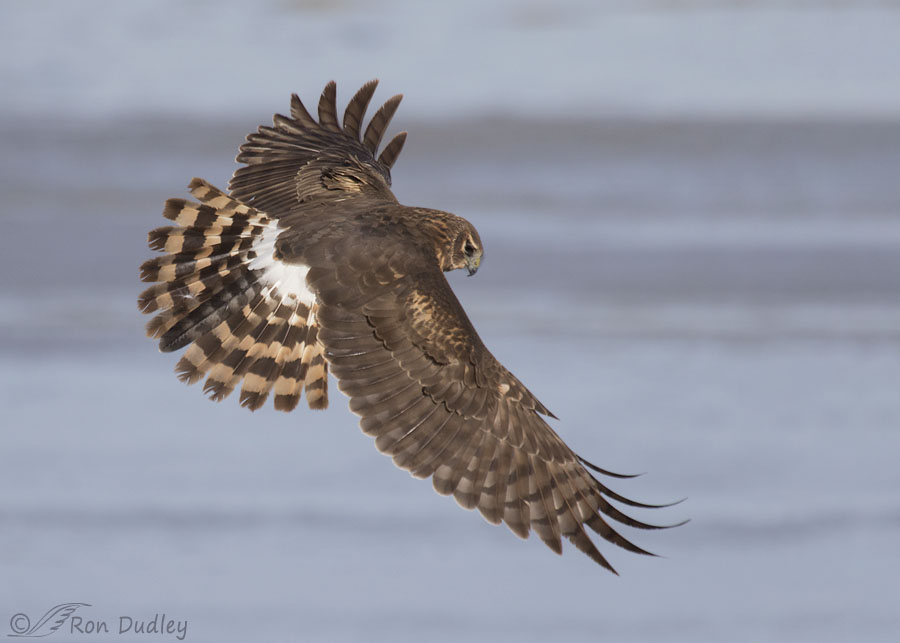
1/2000, f/8, ISO 500, Canon 7D Mark II, Canon 100-400 @ 400mm, 1.4 tc, canvas added for composition, not baited, set up or called in
I took this photo of a Northern Harrier hunting along the causeway to Antelope Island in January of 2015. As soon as I saw it on my big screen that single, almost black, central tail feather jumped out at me so I asked Jerry Liquori about it. Jerry is a noted authority on raptor ID – he’s written several highly respected books on the subject and really knows his stuff. Jerry said that it’s pretty typical for harriers to have two central tail feathers that are darker or less marked than the others.
So I looked back on some of my older photos of harriers where I could see the dorsal surface of their flared tails and sure enough…
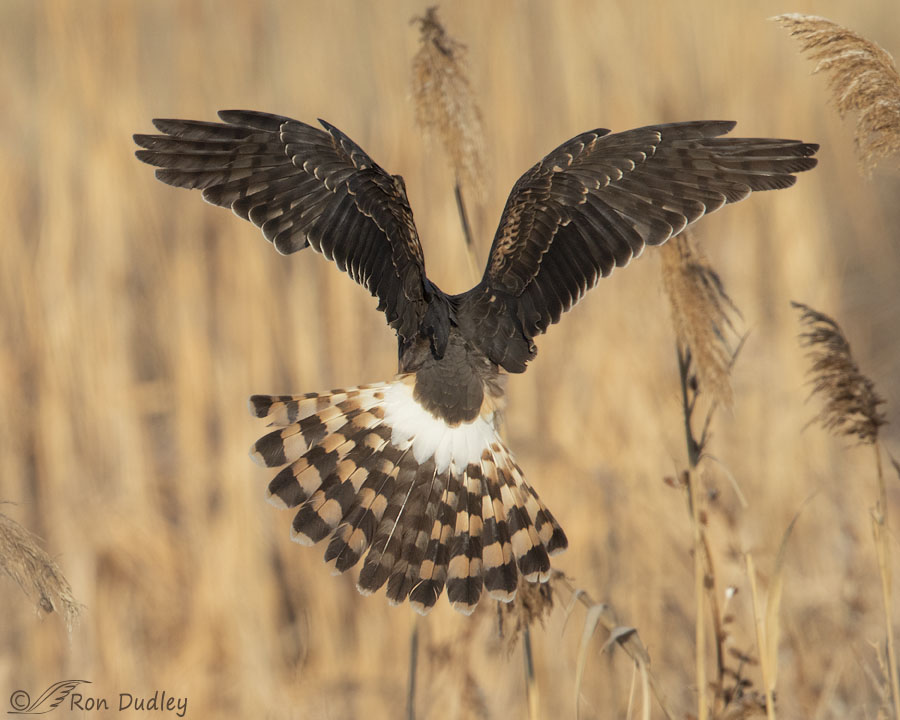
many of them, though not all, had two central tail feathers what were noticeably darker, and/or less marked, than the others.
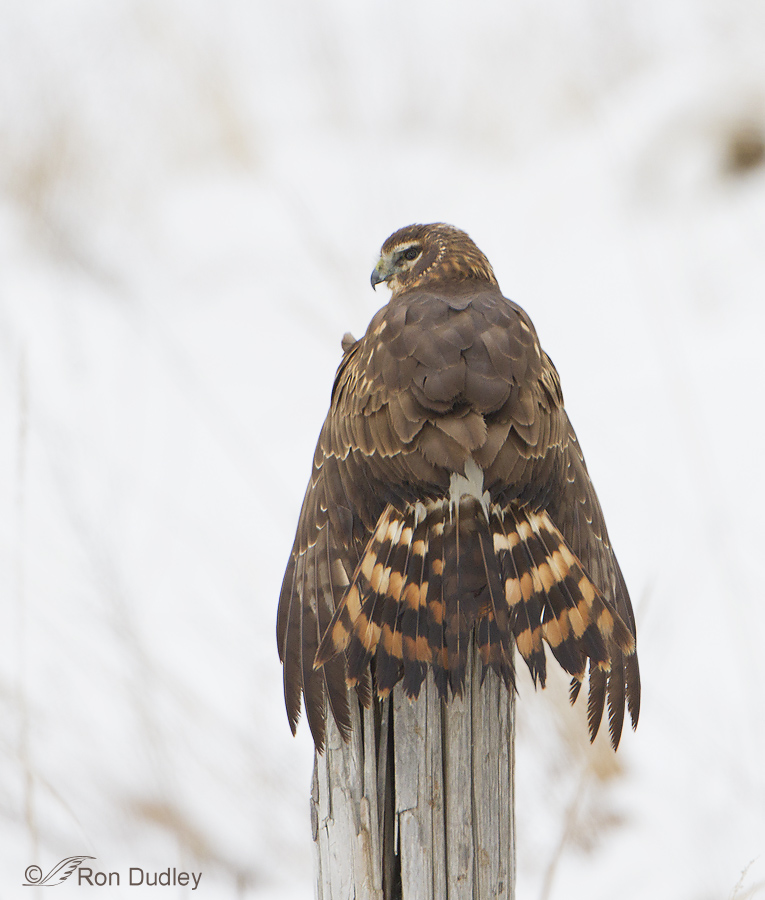
This one was drying out after a wet snow but even sopping wet the two darker central tail feathers are apparent.
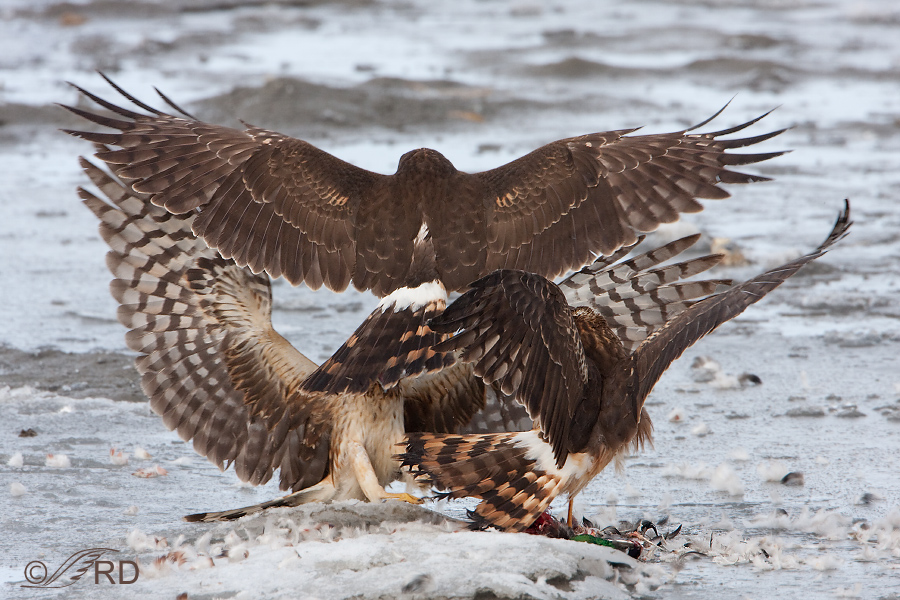
In this photo three harriers are fighting over prey. The darker central tail feathers can be seen in two of them.
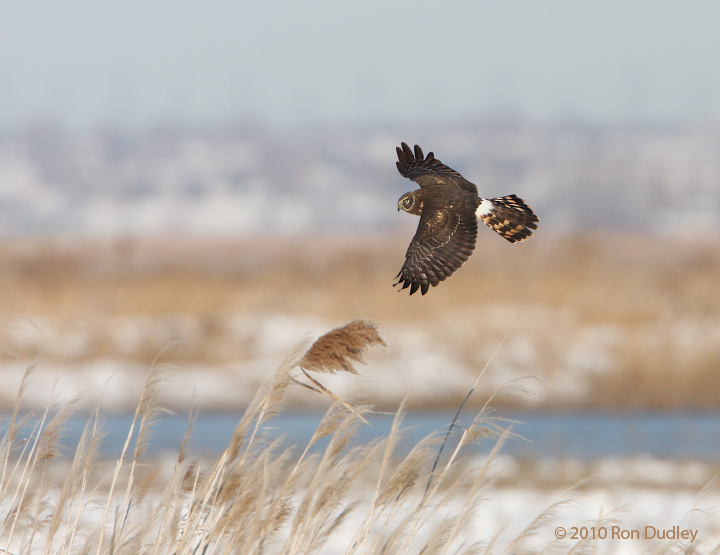
Even from a distance the darker tail feathers can be apparent. A pretty good field mark, actually.
So why did I say in my title that the harrier in photo # 1 was “unusual” if dark central tail feathers are typical? Notice that Jerry said that it’s typical for harriers to have two central tail feathers that are dark. My harrier has only one so he called that bird “unusual”. He told me that the single dark feather is not the result of a normal molt cycle, but instead its predecessor had either been pulled out or damaged and then replaced independent of the cycle.
Jerry provided me a link to a blog post on the subject he wrote for HawkWatch International. Some blog followers may be interested in his explanation and photos that can be seen here, especially the photo of a juvenile Northern Harrier.
Thanks, Jerry.
Ron


Thanks Ron! I had never noticed or thought about this particular plumage feature before. When the tail is closed at rest the two central “deck” feathers are folded in at the top largely covering the rest of the tail feathers and are thus the most fully exposed to both the sun and to potential visual predators and prey. Extra melanin would strengthen them from sun damage and might also be better camouflage which would be particularly important in a commonly ground perching harrier.
Thank you and Jerry.
I wonder why it is so, but am v grateful to have it pointed out to me.
Starting my day with learning puts it off to a very good start. And is a distinct improvement on pilling the cat which is part of the reason I am late to the party today.
EC, I’ve never had to do it because I’ve never actually owned a cat but pilling a cat sounds about as difficult a task as trying to herd them.
It isn’t a heap of fun and can involve bloodshed. Sadly he will need two pills a day for the rest of his life. I am however grateful that it is only two. I take rather more than that myself.
Lots of “WOW!” in these shots, Ron. They are marvelous! I noticed the single dark tail feather of the first bird because it didn’t look symmetrical, so I (am such a nerd) counted the lighter feathers — 5 on the right; 6 on the left.
Interesting that today’s post has a connection to Jerry. I was thinking about him earlier this week and wondering how he and Sherry are. 💞
Marty, I haven’t heard anything about Jerry for quite a while. I’ve stopped in to HawkWatch headquarters three times during the pandemic specifically to ask about Jerry but because of Covid they’ve always been closed to the public. But the last time I heard anything it wasn’t good news.
You have an amazing eye for detail. I looked through several apps (including Raptor ID) and several books. Not surprisingly, the only mention of the darker central retrices, besides Jerry’s article, is in BotW. Virtually none of the apps or the books I referenced even show this feature. Well done. Any evidence of this differential coloration on the male?
“Any evidence of this differential coloration on the male”
Lyle, Last night I looked through my photos of adult males and didn’t see any. But then I don’t have many photos of adult males showing the dorsal surface of the tail while it’s flared.
This is an interesting feature, but I can’t think of a reason for this. As Barbara indicated, darker feathers have increased melanin and this does give greater strength to a feather. Such a feather is more resistant to degradation from bacteria and fungi and it is mechanically stronger and less easily broken and more slowly worn away. Friction with the air causes significant feather wear so it is important to have darker flight feathers for birds with long distance migrations. Note the darker wings of many songbirds and waterfowl. And, the dark tails are important to woodpeckers who use the tail as a prop. But none off these features would seem to be necessary in the central tail feathers of a Harrier. Many birds have dark patterns in their tails that may be for display or other reasons unrelated to mechanical strength. So maybe there is a reason but I don’t know it. It’s just in the genetic makeup of the Harrier and if there is no disadvantage there is no pressure for this feature to disappear.
Thanks for your input, Dan. That’s right, selection pressure can work both ways depending on if a feature is an advantage or disadvantage. But if it’s neither there should be no selection pressure.
The third photo with the wet harrier looking like Batman is wonderful! Love learning from you Ron.
I noticed that Batman impersonation too, Kathleen.
Goes to show we or I am not too old to learn something new! Many thanks!!
Nope, we’re never too old!
Interesting indeed. It’s a detail I may not have noticed on my own and all the photos are absolutely gorgeous and interesting in their own right for lots of other reasons so I’m glad you choose to revisit these shots.
Thanks very much, Pat.
Ron, you will always be a science teacher!!! Thanks for this. I had no idea. When you don’t know, you consult the experts.
“When you don’t know, you consult the experts”
Exactly, Nancy. And when it comes to raptor ID, hawks especially, no one I’m aware of is more expert than Jerry.
Great and intriguing series, Ron! I suspect Dan Gleason might chime in a bit later, but it’s my understanding that darker feathers are generally stronger, more durable in terms of holding up under flight conditions, due to the actual structural aspects of the dark pigment.
So, might there be an evolutionary need for greater strength in these central tail feathers? Are they more often stressed to the point of damage? Could the protective aspects of the darker pigment be the reason for them? And I wonder why they aren’t in all such Harriers?
Good potential connection to make, Barbara. I knew that background info but never made the connection.
After further review, I believe the bird in the first photo has one dark feather and one semi-dark feather. The rest of the tail is lighter. So there are two darker feathers. Is this my imagination?
I’d say it’s darker but not significantly darker and nowhere near as dark as the darkest one.
Very interesting post and excellent photos as always. I have to admit that I am not that observant to have noticed that. And the kestrels too. I have taken hundred of Kestrels photos and never noticed anything unusual about the tail feathers. I will have to test some of my fellow Kestrel restoration friends. Our Harriers don’t stay here during the summer. Possibly some are up there in your area.
Thanks, Everett. Interesting that you don’t have harriers in summer. Ours are resident year-round.
I have to wonder what the evolutionary advantage is of having those darker, central tail feathers. It can’t be just so they can flip me a blurry middle feather as they depart, unphotographed. While they seem to find that fun, I see no particular advantage to the bird in that particular behavior!
Do you know whether this trait is seen across North America? Or could it be regional?
“Do you know whether this trait is seen across North America? Or could it be regional?”
Porcupine, I don’t know for fact but I’d be very surprised if it’s regional. Jerry’s blog is written for an international audience.
Interesting! Always some “detail” that goes unnoticed until…….. 😉 Thx for the link on other “details” in other raptors that might also go unnoticed particularly when just watching them in flight.
“Always some “detail” that goes unnoticed”
Judy, I published the original post in 2015. By then I’d been photographing harriers, often, for about eight years and their dark central tail feathers had never registered with my brain. Duh!
Beautiful docu-series, and great education, thank you.
Thanks, Elmer.
Stunning shots regardless of tail feathers! I like action shots so your 3 harriers fighting and the second one of a take-off or landing are super nice.
Thank you, Terri.